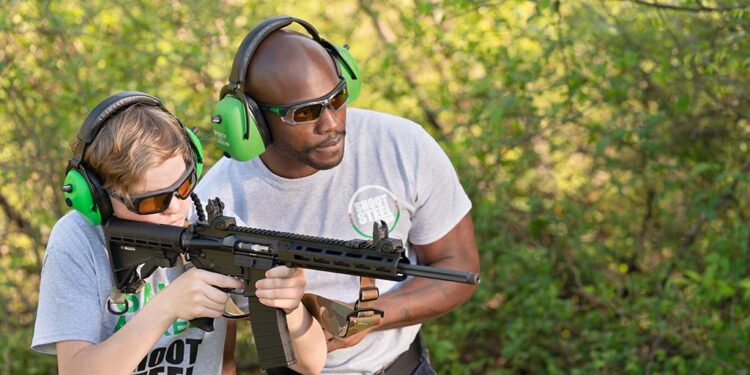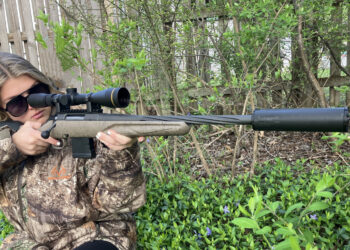By Oleg Volk
“It’s good to have a rifle. It’s better to be good with it.”
Proficiency requires practice. Practice takes time, facilities and ammunition. Rimfire clones of centerfire arms reduce the demands on the range backstop and noise abatement and significantly reduce ammunition expense. Additionally, greatly reduced recoil also reduces wear on the shooter.
The trouble with rimfire clones is the general lack of similarity of the manual of arms to the centerfire originals. A further problem is reduced reliability. These issues are quite pronounced with the .22 conversion kit for AR-15 and with most of the clones. For example, many clones lock the bolt on the magazine follower, so that the action closes once the empty magazine drops. A few lack functional bolt release flappers. Fortunately, Tippmann Arms (tippmannarms.com) approached this problem seriously and came up with an M4-22 that’s true to the original 5.56mm rifle in all but the caliber. The M4-22’s controls perfectly match the centerfire’s original, and so does its overall balance. The gun is only slightly lighter than the genuine M4 carbine, and the balance is exactly the same; even the dust cover and the forward assist are genuine.
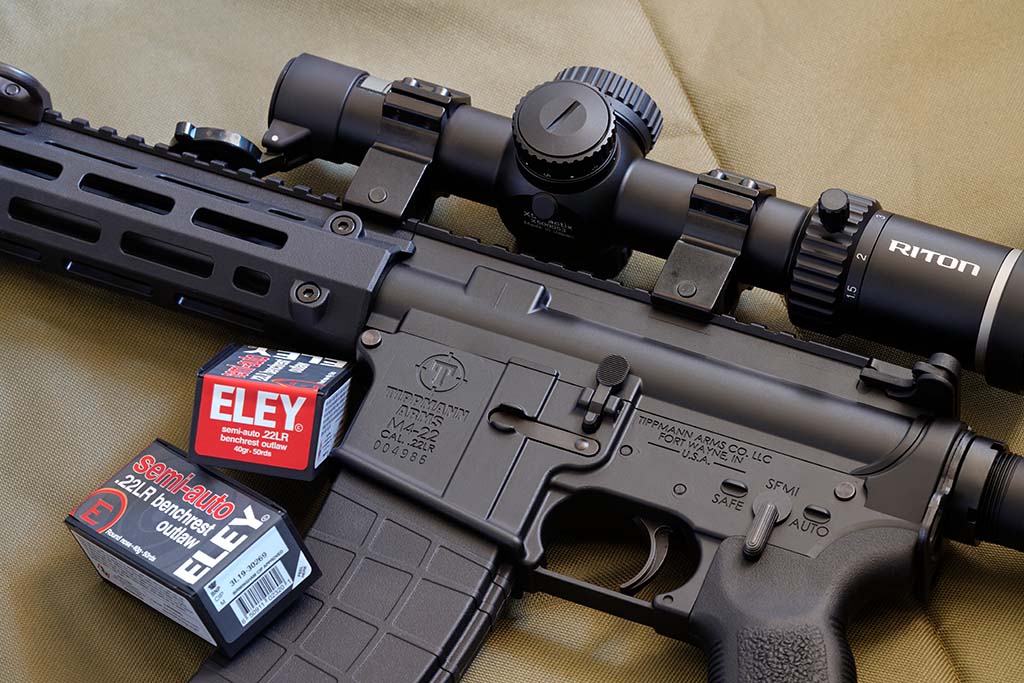
The rimfire trainer rifle also matches the reliability of the original, permitting over 1,500 rounds before detailed cleaning is required. The key to the M4-22’s reliability lies in the design from the magazine up. The 25-round magazine looks like a standard AR-15 polymer mag but has a textured button on the left side. Pressing the button allows the protective outer shell to slide down to the next detent, giving access to the magazine follower tab for easy loading. This way, the loading advantages of a skeletonized magazine are retained while keeping dust and dirt off the ammunition while in use. Plastic feed lips are reinforced with a steel insert for longevity.
While the magazine appears to be of standard size, it is fractionally wider than usual and has a retention latch located in a different spot. The Tippmann lower is not interchangeable with centerfire uppers; although it can use standard aftermarket AR triggers (but not the safety lever), stocks and forends. The rifle comes with folding mechanical sights of original design: a two-aperture flip rear becomes a shallow notch when folded; likewise, the post front becomes a short blade when folded. That makes the sights useful for the pistol version of this gun. Unfortunately, the rear sight is just a little too tall even when folded for the 1-6x FFP Riton scope I used for accuracy testing. The trigger is typical for an AR-15—a 4.6-pound single-stage design not really conducive to match accuracy. To my mind, that’s not much of a disadvantage, since the entire rig was meant to reproduce M4 carbine performance for training.
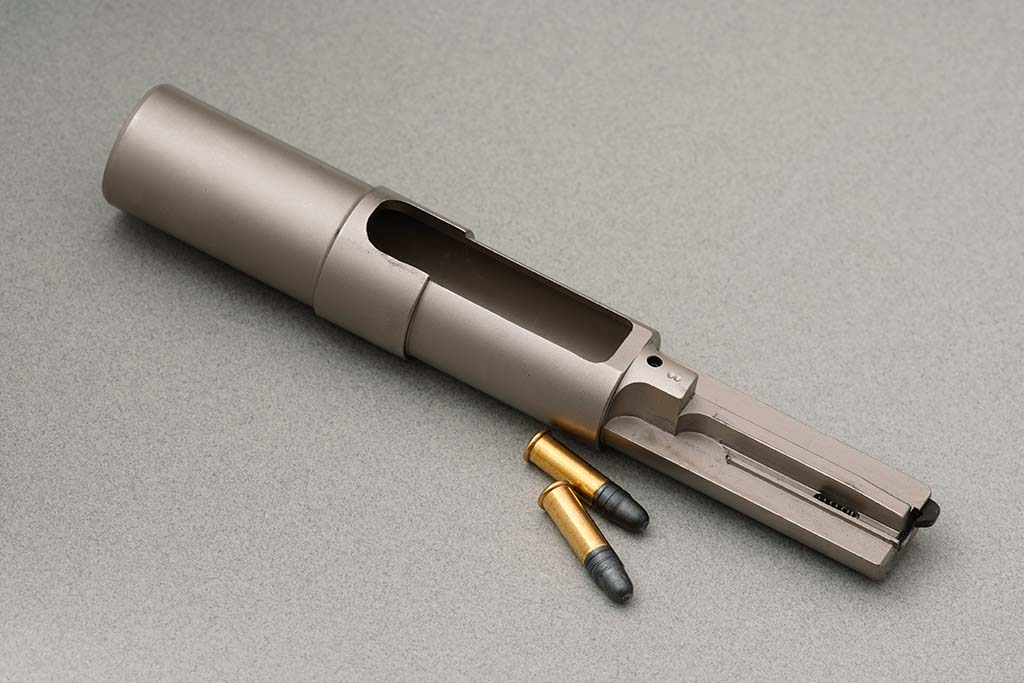

The polymer forend with M-LOK slots on seven of its eight facets and a Picatinny rail on top are comfortable in use. The pistol grip is likewise a good fit for a variety of hand sizes. The four-position telestock could use a more positive locking lever spring, but it’s entirely adequate. The aluminum upper and lower receivers match up cleanly. The overall quality of the build is very good.
In use, the gun lives up to the billing. I have used several variants of the M4-22, including a select-fire variant firing at the correct 800 to 850 rpm and a prototype of the accurized model: not a single one of these guns have malfunctioned in use, and that includes a suppressed version firing subsonics. Take-down for cleaning is the same as with the 5.56mm guns, but the bolt and carrier are a single unit slotted on top for the protruding extension of the charging handle.
The bolt is very light at 5.25 ounces. For comparison, an M16 bolt carrier group (BCG) weighs 11.6 ounces. The buffer is closer to standard weight at 4.25 ounces counting the spring. The light weight of the moving parts allows the retention of a fairly strong recoil/return spring, so the experience of racking the bolt is consistent with the centerfire version. This spring also closes the bolt with enough authority for reliable feeding.
The rifle is available with a 16-inch barrel, either round with an A2 birdcage flash hider or a fluted barrel with a thread protector because 7- and 11-inch barrels are available with braced pistol variants that work well for younger shooters. Depending on the model, magazines are available in 10-, 15- or 25-round capacities. The mags fit standard AR-15 carriers and can stand up to relatively rough treatment without damage.
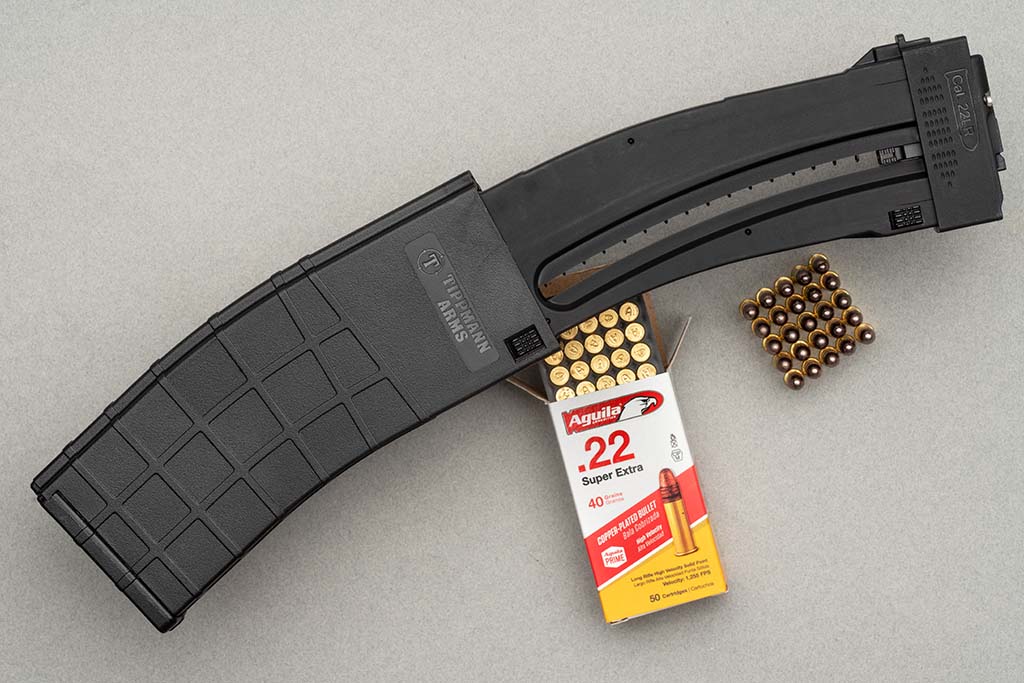
I limited my accuracy testing to two loads: CCI® Clean, my standard ammunition for semi-autos, and ELEY© Benchrest Outlaw, both launching supersonic 40-grain bullets. Feeding was, as always, completely reliable. As a compromise between iron sights and a target scope, I used a Riton tactical illuminated 1-6x FFP optic. Accuracy was limited primarily by the trigger and by my skill level, but at least the results were consistent. With the rifle shot from a small sandbag, the CCI load grouped around 2MOA and the ELEY around 1.5MOA. With 40 yards near zero and 50 yards far zero, adjusting to a 100-yard, 8-inch steel plate was easy: the drop was almost exactly 5MOA, and the hash marks on the Riton scope reticle are spaced by the same amount. At 100 yards, I could hit a 3-inch spinner from field positions almost every time, even when it was already moving from the previous shots. I am sure that most Project Appleseed™ graduates could improve on my results, but I am more of a photographer than a marksman.

The M4-22 is a genuinely pleasant firearm, so the 140 rounds needed to zero the scope and shoot the test groups will become a brick or three over the coming weeks. I have an excellent Geissele SSA® trigger earmarked for the eventual upgrade, but keeping the gun stock would help me learn more effectively. The one thing that rimfire clones do not provide is the authentic recoil, so they’re great for practicing rapid target acquisition up-close—without tearing up a steel target or fragging myself with bullet jacket pieces—but not for mastering muzzle rise control.
A Must-Have I have numerous rimfire clones of an AR-15 on hand. While some of them, like my Smith & Wesson M&P15-22, match the Tippmann in reliability and get close in accuracy, they do not provide quite the genuine interface experience. Other clones lack the reliability, which isn’t surprising considering the challenges posed by the .22 LR feeding and extraction cycle. The makers of this M4-22 managed to surmount those challenges in style, creating a must-have .22 for serious training.
| This article first appeared in Small Arms Review V25N1 (January 2021) |



